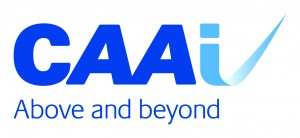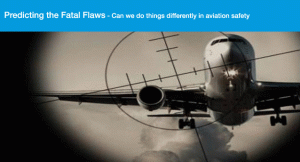Predicting the fatal flaws: can we do things differently in aviation safety?
A Conference presented by
Royal Aeronautical Society Human Factors Group,
NATS – National Air Traffic Services
Chartered Institute of Ergonomics and Human Factors
and hosted by
Virgin Atlantic Airways
Virgin Atlantic Airways, The Base, Manor Royal, Crawley, Gatwick
Thursday and Friday, 26/27 November, 2015
Programme Summary and Presentation Materials
N.B. All documents and files published here are copyright (c) by their author(s) and reproduced with consent solely for aviation safety research use. Links to information are published when provided by authors.
| Time | Topic | Speaker | Notes |
Day 1 |
|||
| 0830 | Registration | Tea and coffee sponsored by HeliOffshore:  |
|
| Introduction | |||
| 0915 | Welcome and housekeeping | Nicole Svatek Chair, RAeS Human Factors Group |
|
| Day 1 Keynote: Is there a Problem? | |||
| 0930 | New forms of Regulation for the Human Factors of Aviation Safety | Prof. Chris Johnson, Head of Computing Science, Glasgow University | Existing forms of regulation have provided strong support for human factors in aviation safety. However, the public-private relationships that have grown up over previous decades are arguably insufficient to protect us in future. |
Accidents and What they Tell Us |
|||
| 1015 | Issues Arising from the Helios Disaster | Lieutenant Colonel Panagiotis Stathopoulos, Hellenic Air Force | Account and factors arising from the Helios accident including hypoxia, human factors in aircraft design and Alerting, automation and other issues from a military perspective – see Abstract. |
| 1100 | Tea and coffee break sponsored by LMQ Ltd  |
||
| 1120 | Safety nets for Airborne Conflict | Stanislaw Drozdowski, Senior ACAS Expert, Eurocontrol |
The presentation introduces the existing safety nets against midair collisions and their interactions with human operators (pilots, controllers). These interactions will be further illustrated by a description of a recent incident. As the world of safety nets is evolving, the speaker describes forthcoming changes to them and how these changes may introduce additional challenges.
|
What Has to Change? |
|||
| 1150 | Developing a Just Culture to achieve an effective safety-focused Management System | Nick Clutton, Former B767, 757 and 737 pilot with BA, Astraeus and Ethiopian Airlines, multi-crew training, CRM developer and author | The speaker describes a development of the Just Culture that adopts a holistic systems approach with supporting toolkits to enable a Management System (MS or SMS) to function as intended. (See the HCAP discussion paper “Culture and Safety Management“.) |
| 1220 | Question Time | Morning Panelists, Moderator: Maj. Mike Baker MAA MOD | |
| 1300 | Conference Lunch sponsored by  BooHoo.com: BooHoo.com: |
||
| 1410 | Helen Muir Award Presentation |  |
Sponsored by Ashgate Publishing |
| 1420 | CIEHF: Designing for People |
Jon Berman, Director, Greenstreet Berman Ltd and Past President of the Chartered Institute of Ergonomics and Human Factors (CIEHF) |
‘The Chartered Institute of Ergonomics & Human Factors has been promoting ‘designing for people’ to good effect since 1949. By taking into account the capabilities and situation of the person at the centre of an interaction with other people, technologies, equipment or any kind of live environment, ergonomists (also termed human factors specialists) aim to contribute to the design of safe, productive spaces, equipment and procedures’. |
| 1430 | The Art of Measuring Nothing |
Eric Arne Lofquist, Associate Professor, Department of Leadership and Organizational Behaviour, BI Norwegian Business School – Campus Bergen. | Prof. Lofquist discusses a safety model that shifts the focus from traditional safety monitoring mechanisms (risk analysis and trial and error learning) to the natural interactivity within socio-technical systems found in high reliability organizations. The presentation includes empirical results of an alternate methodology for measuring perceived changes in safety at the operational level. |
| 1505 | Tea and coffee break |  |
Sponsored by Ashgate Publishing |
| 1525 | Through a Glass Darkly: Safety at the pilot-controller interface | Dr. Anne Isaac, Head of Human Performance in External Safety, NATS | Concentrating on past occurrences gives us a one dimensional view of system safety, and typically one which is negative. Developing ways of assessing system safety on a day to day basis and observing good practice has proven to give a more accurate picture of ‘work as done’. This practical approach has increased the understanding of both the ATC system, the flight-deck and the risk prone interface between the two professions. |
| 1600 | Question Time | Afternoon Panelists, Moderator: Mariann Hintz, Senior ATM Expert, Eurocontrol | Panelists and Safety II practitioner from Flybe |
| 1645 | Day 1 Close | ||
| 1710 | Conference Reception | Sponsored by NATS | |
Day 2 |
||||
| 0830 | Registration | Tea and coffee sponsored by Baines Simmons |
||
| 0915 | Welcome and housekeeping | Nicole Svatek, HFG Chair | ||
| 0930 | Continuity and Reality check | Capt. Mike Freeman, TRI/TRE, RAeS Human Factors Group | What did we learn from Day 1? What do we need to do now to anticipate and avoid the ‘Fatal Flaws’? | |
| 0945 | Management or Safety Management | Jon Berman, Past President CIEHF; Director, Greenstreet Berman Ltd | What it is we can expect from SMS and whether an SMS can ever be an RMS (Risk Management System).The ‘Management System’ is actually the RMS – do we need to be clearer about what that means for behaviours throughout the organisation? | |
| 1015 | “From Pyramids to Pepsi”: A critical look at the challenges our industry is likely to face in the coming decades | Capt. Harry Nelson, Executive Operational Advisor to Product Safety, Airbus | The talk looks at what is likely to change and what will probably not change so much in the aviation scene over the coming years. The paradoxes that this change dynamic produces will largely have a human perspective. How the human is integrated and equipped to manage the various and sometimes conflicting pressures will directly impact operating safety levels; how the industry as a whole faces this future will determine the eventual level of achievable safety. | |
| 1100 | Tea and coffee break | |
Sponsored by Elsevier Publishing | |
| 1120 | Conflict Zone overflight | Captain Giancarlo Buono, IATA Regional Director Safety and Flight Operations, Europe | Conflict Zone overflight and security issues’ effect on teamworking and safety – how do we identify emerging risks including those coming from commercial pressures? | |
| 1150 | Question Time | Morning Panelists, Moderator: Capt. Tim Rolfe, Bristow Group | ||
| 1230 | Lunch | |||
Where Are We Going From Here? |
||||
| 1330 | The Challenge of the Unpredictable | Dr. Jean Paries, Président-directeur général, Cabinet Dédale; president of the Resilience Engineering Association | ||
| 1400 | EASA Safety Risk Management | John Franklin, Head Safety Analysis and Research, EASA | EASA is finalising a new Safety Risk Management process for the governance and management of the European Aviation Safety Plan. This will lead to the establishment of safety risk portfolios for different aviation sectors. The presentation draws on example portfolios to show the active involvement of external stakeholders in the process through the European Strategic Safety Initiative (ECAST/ EHEST/ EGAST) and the European HF Group. | |
| 1430 | Transforming the Flight Deck |
Prof. Guy Boy, Director, Florida Institute of Technology Human-centered Design, Chair of IEA Technical Committee for Human Factors | ||
| 1500 | Tea and coffee break |  |
Sponsored by CAA International – See Sponsors page. | |
| 1515 | Is there a role for the human controller in future ATM? | Marc Baumgartner, IFATCA SESAR / EASA coordinator | Is our grasp of evolving teamwork and systemic communication, particularly ATC/FD, adequate to cope with emerging risks? How can SESAR help model the impact of ‘big data’ on other flight operational areas? | |
| 1545 | Finding a Balance | Dr. Kathy Abbott, FAA Chief Scientific and Technical Advisor, Flight Deck Human Factors | ||
| 1615 | Question Time | Afternoon Panelists, Moderator: Simon Roberts, SMS Programme Manager, CAA | ||
| 1640 | Washup and Close | Nicole Svatek, HFG Chair, and Capt. Mike Freeman, TRI/TRE, RAeS Human Factors Group | Are SMS and operational risk assessment as currently understood and implemented still fit for purpose? Is there a consensus for change? | |

